+ Open data
Open data
- Basic information
Basic information
| Entry | Database: PDB / ID: 6ete | ||||||
|---|---|---|---|---|---|---|---|
| Title | Crystal structure of KDM4D with tetrazolhydrazide compound 5 | ||||||
 Components Components | Lysine-specific demethylase 4D | ||||||
 Keywords Keywords |  OXIDOREDUCTASE / OXIDOREDUCTASE /  KDM4D / KDM4D /  ligand binding / Tetrazolylhydrazide / ligand binding / Tetrazolylhydrazide /  tetrazole / inhibitor design / tetrazole / inhibitor design /  cancer / cancer /  epigenetics epigenetics | ||||||
| Function / homology |  Function and homology information Function and homology informationpositive regulation of chromatin binding / histone H3K9me2/H3K9me3 demethylase activity / [histone H3]-trimethyl-L-lysine9 demethylase / positive regulation of double-strand break repair via nonhomologous end joining / histone H3K9 demethylase activity / histone demethylase activity / pericentric heterochromatin / cellular response to ionizing radiation / double-strand break repair via homologous recombination /  regulation of protein phosphorylation ...positive regulation of chromatin binding / histone H3K9me2/H3K9me3 demethylase activity / [histone H3]-trimethyl-L-lysine9 demethylase / positive regulation of double-strand break repair via nonhomologous end joining / histone H3K9 demethylase activity / histone demethylase activity / pericentric heterochromatin / cellular response to ionizing radiation / double-strand break repair via homologous recombination / regulation of protein phosphorylation ...positive regulation of chromatin binding / histone H3K9me2/H3K9me3 demethylase activity / [histone H3]-trimethyl-L-lysine9 demethylase / positive regulation of double-strand break repair via nonhomologous end joining / histone H3K9 demethylase activity / histone demethylase activity / pericentric heterochromatin / cellular response to ionizing radiation / double-strand break repair via homologous recombination /  regulation of protein phosphorylation / HDMs demethylate histones / chromatin DNA binding / site of double-strand break / regulation of protein phosphorylation / HDMs demethylate histones / chromatin DNA binding / site of double-strand break /  regulation of gene expression / blood microparticle / damaged DNA binding / regulation of gene expression / blood microparticle / damaged DNA binding /  chromatin remodeling / chromatin remodeling /  inflammatory response / inflammatory response /  chromatin / chromatin /  nucleoplasm / nucleoplasm /  metal ion binding / metal ion binding /  nucleus nucleusSimilarity search - Function | ||||||
| Biological species |   Homo sapiens (human) Homo sapiens (human) | ||||||
| Method |  X-RAY DIFFRACTION / X-RAY DIFFRACTION /  SYNCHROTRON / SYNCHROTRON /  MOLECULAR REPLACEMENT / Resolution: 1.468 Å MOLECULAR REPLACEMENT / Resolution: 1.468 Å | ||||||
 Authors Authors | Malecki, P.H. / Weiss, M.S. / Heinemann, U. / Link, A. | ||||||
 Citation Citation |  Journal: To be published Journal: To be publishedTitle: Crystal structure of KDM4D with tetrazolylhydrazide ligand NR128 Authors: Malecki, P.H. / Link, A. / Weiss, M.S. / Heinemann, U. | ||||||
| History |
|
- Structure visualization
Structure visualization
| Structure viewer | Molecule:  Molmil Molmil Jmol/JSmol Jmol/JSmol |
|---|
- Downloads & links
Downloads & links
- Download
Download
| PDBx/mmCIF format |  6ete.cif.gz 6ete.cif.gz | 235.4 KB | Display |  PDBx/mmCIF format PDBx/mmCIF format |
|---|---|---|---|---|
| PDB format |  pdb6ete.ent.gz pdb6ete.ent.gz | 201 KB | Display |  PDB format PDB format |
| PDBx/mmJSON format |  6ete.json.gz 6ete.json.gz | Tree view |  PDBx/mmJSON format PDBx/mmJSON format | |
| Others |  Other downloads Other downloads |
-Validation report
| Arichive directory |  https://data.pdbj.org/pub/pdb/validation_reports/et/6ete https://data.pdbj.org/pub/pdb/validation_reports/et/6ete ftp://data.pdbj.org/pub/pdb/validation_reports/et/6ete ftp://data.pdbj.org/pub/pdb/validation_reports/et/6ete | HTTPS FTP |
|---|
-Related structure data
| Similar structure data |
|---|
- Links
Links
- Assembly
Assembly
| Deposited unit | 
| ||||||||
|---|---|---|---|---|---|---|---|---|---|
| 1 |
| ||||||||
| Unit cell |
|
- Components
Components
-Protein , 1 types, 1 molecules A
| #1: Protein | Mass: 39491.793 Da / Num. of mol.: 1 / Fragment: JMJD2D Source method: isolated from a genetically manipulated source Source: (gene. exp.)   Homo sapiens (human) / Gene: KDM4D, JHDM3D, JMJD2D / Production host: Homo sapiens (human) / Gene: KDM4D, JHDM3D, JMJD2D / Production host:   Escherichia coli BL21(DE3) (bacteria) Escherichia coli BL21(DE3) (bacteria)References: UniProt: Q6B0I6,  Oxidoreductases; Acting on paired donors, with incorporation or reduction of molecular oxygen; With 2-oxoglutarate as one donor, and incorporation of one atom of oxygen into each donor Oxidoreductases; Acting on paired donors, with incorporation or reduction of molecular oxygen; With 2-oxoglutarate as one donor, and incorporation of one atom of oxygen into each donor |
|---|
-Non-polymers , 6 types, 364 molecules 
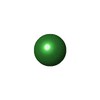


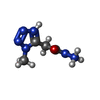






| #2: Chemical | ChemComp-ZN / | ||||||||
|---|---|---|---|---|---|---|---|---|---|
| #3: Chemical |  Nickel Nickel#4: Chemical | ChemComp-EDO /  Ethylene glycol Ethylene glycol#5: Chemical |  Sulfate Sulfate#6: Chemical | ChemComp-BWK / [ | #7: Water | ChemComp-HOH / |  Water Water |
-Experimental details
-Experiment
| Experiment | Method:  X-RAY DIFFRACTION / Number of used crystals: 1 X-RAY DIFFRACTION / Number of used crystals: 1 |
|---|
- Sample preparation
Sample preparation
| Crystal | Density Matthews: 2.53 Å3/Da / Density % sol: 51.42 % |
|---|---|
Crystal grow | Temperature: 293 K / Method: vapor diffusion / pH: 7 / Details: 100mM HEPES, 180mM ammonium sulphate, 24% PEG 3350 |
-Data collection
| Diffraction | Mean temperature: 100 K | ||||||||||||||||||||||||||||||||||||||||||||||||||||||||||||||||||||||||||||||||||||||||||||||||||||
|---|---|---|---|---|---|---|---|---|---|---|---|---|---|---|---|---|---|---|---|---|---|---|---|---|---|---|---|---|---|---|---|---|---|---|---|---|---|---|---|---|---|---|---|---|---|---|---|---|---|---|---|---|---|---|---|---|---|---|---|---|---|---|---|---|---|---|---|---|---|---|---|---|---|---|---|---|---|---|---|---|---|---|---|---|---|---|---|---|---|---|---|---|---|---|---|---|---|---|---|---|---|
| Diffraction source | Source:  SYNCHROTRON / Site: SYNCHROTRON / Site:  BESSY BESSY  / Beamline: 14.1 / Wavelength: 0.918 Å / Beamline: 14.1 / Wavelength: 0.918 Å | ||||||||||||||||||||||||||||||||||||||||||||||||||||||||||||||||||||||||||||||||||||||||||||||||||||
| Detector | Type: DECTRIS PILATUS 6M / Detector: PIXEL / Date: May 4, 2016 | ||||||||||||||||||||||||||||||||||||||||||||||||||||||||||||||||||||||||||||||||||||||||||||||||||||
| Radiation | Monochromator: DOUBLE CRYSTAL / Protocol: SINGLE WAVELENGTH / Monochromatic (M) / Laue (L): M / Scattering type: x-ray | ||||||||||||||||||||||||||||||||||||||||||||||||||||||||||||||||||||||||||||||||||||||||||||||||||||
| Radiation wavelength | Wavelength : 0.918 Å / Relative weight: 1 : 0.918 Å / Relative weight: 1 | ||||||||||||||||||||||||||||||||||||||||||||||||||||||||||||||||||||||||||||||||||||||||||||||||||||
| Reflection | Resolution: 1.47→47.923 Å / Num. obs: 127491 / % possible obs: 99.8 % / Observed criterion σ(I): -3 / Redundancy: 4.607 % / Biso Wilson estimate: 18.05 Å2 / CC1/2: 0.999 / Rmerge(I) obs: 0.044 / Rrim(I) all: 0.049 / Χ2: 1.146 / Net I/σ(I): 18.16 / Num. measured all: 587371 | ||||||||||||||||||||||||||||||||||||||||||||||||||||||||||||||||||||||||||||||||||||||||||||||||||||
| Reflection shell | Diffraction-ID: 1
|
- Processing
Processing
| Software |
| ||||||||||||||||||||||||||||||||||||||||||||||||||||||||||||||||||||||||||||||||||||||||||||||||||||||||||||||||
|---|---|---|---|---|---|---|---|---|---|---|---|---|---|---|---|---|---|---|---|---|---|---|---|---|---|---|---|---|---|---|---|---|---|---|---|---|---|---|---|---|---|---|---|---|---|---|---|---|---|---|---|---|---|---|---|---|---|---|---|---|---|---|---|---|---|---|---|---|---|---|---|---|---|---|---|---|---|---|---|---|---|---|---|---|---|---|---|---|---|---|---|---|---|---|---|---|---|---|---|---|---|---|---|---|---|---|---|---|---|---|---|---|---|
| Refinement | Method to determine structure : :  MOLECULAR REPLACEMENT / Resolution: 1.468→35.732 Å / SU ML: 0.13 / Cross valid method: FREE R-VALUE / σ(F): 1.33 / Phase error: 14.98 / Stereochemistry target values: ML MOLECULAR REPLACEMENT / Resolution: 1.468→35.732 Å / SU ML: 0.13 / Cross valid method: FREE R-VALUE / σ(F): 1.33 / Phase error: 14.98 / Stereochemistry target values: ML
| ||||||||||||||||||||||||||||||||||||||||||||||||||||||||||||||||||||||||||||||||||||||||||||||||||||||||||||||||
| Solvent computation | Shrinkage radii: 0.9 Å / VDW probe radii: 1.11 Å / Solvent model: FLAT BULK SOLVENT MODEL | ||||||||||||||||||||||||||||||||||||||||||||||||||||||||||||||||||||||||||||||||||||||||||||||||||||||||||||||||
| Displacement parameters | Biso max: 98.57 Å2 / Biso mean: 27.331 Å2 / Biso min: 8.91 Å2 | ||||||||||||||||||||||||||||||||||||||||||||||||||||||||||||||||||||||||||||||||||||||||||||||||||||||||||||||||
| Refinement step | Cycle: final / Resolution: 1.468→35.732 Å
| ||||||||||||||||||||||||||||||||||||||||||||||||||||||||||||||||||||||||||||||||||||||||||||||||||||||||||||||||
| Refine LS restraints |
| ||||||||||||||||||||||||||||||||||||||||||||||||||||||||||||||||||||||||||||||||||||||||||||||||||||||||||||||||
| LS refinement shell | Refine-ID: X-RAY DIFFRACTION / Rfactor Rfree error: 0 / Total num. of bins used: 15
|
 Movie
Movie Controller
Controller



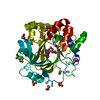
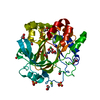
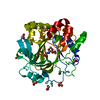
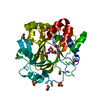

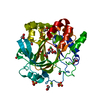
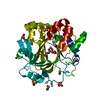
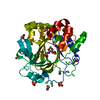

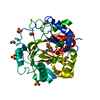

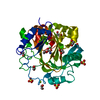
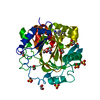
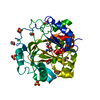
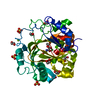

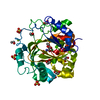
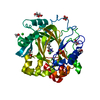
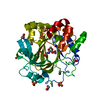
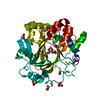
 PDBj
PDBj






